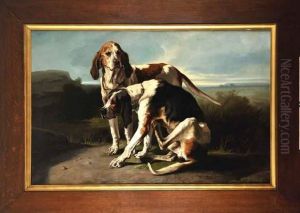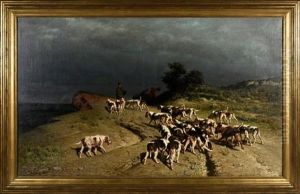Albert De Balleroy Paintings
Albert De Balleroy was a 19th-century French painter known for his animal paintings, particularly those depicting dogs. Born in Paris in 1828, De Balleroy was a contemporary of the Barbizon school artists, although his style was distinct and often focused on the depiction of animals with a remarkable sense of realism and character.
From a young age, De Balleroy showed an exceptional talent for art. He studied under the tutelage of Jean-Baptiste Camille Corot, who was a significant influence on his early work. Corot was a leading figure in the Barbizon school, which was named after the village of Barbizon near the Forest of Fontainebleau, where the artists associated with the movement drew inspiration from nature.
De Balleroy's work, however, diverged from the Barbizon style in its specific concentration on animals as the primary subject matter, although he did share the Barbizon school's interest in naturalistic representation. His most remarkable works often feature dogs, which he painted with a sensitive understanding of their form, personality, and the nuances of their behavior. He was also adept at capturing the relationship between humans and animals, and many of his works include hunters and their loyal canine companions.
Albert De Balleroy's work was well-received in his time, and he exhibited at the prestigious Paris Salon, the official art exhibition of the Académie des Beaux-Arts in Paris. His paintings displayed his ability to capture the movement and vitality of his subjects, making him a sought-after painter for those who wished to have their favorite animals immortalized in art.
De Balleroy's career was relatively short, as he passed away at the age of 45 in 1873. Despite this, his contributions to the genre of animal painting were significant, and his works remain of interest to collectors and animal lovers. His paintings are characterized by their fine detail, the rich texture of the animals' fur, and the atmospheric settings that complement the subjects.
Today, Albert De Balleroy’s paintings can be found in various art collections and museums, and they continue to be appreciated for their charm and technical excellence. His legacy lives on as an artist who provided a unique window into the animal world of his time, capturing the essence of his subjects with a combination of tenderness and anatomical precision.







